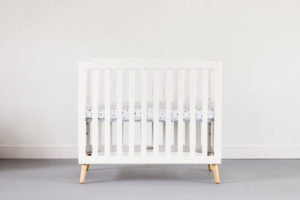What is “Crib hour” or “Crib 60/90”
If you’re like most moms, you’re constantly looking for ways to optimize your time and get the most out of every hour. If your child is struggling with short naps or you are nap training this post is for you. If you’re not sure how to get started with crib hour, keep reading! We’ll give you some tips.
Crib hour is a great way to give the child a chance to fall asleep, and 5-10 minutes is simply not enough time for most babies to learn the skills of falling asleep and self-soothing on their own.
At bedtime, you leave your child (using your chosen training method) as long as it takes him to fall asleep. Babies and children have the most sleep pressure at bedtime, so hopefully, that means the crying won’t last too long (though some babies definitely put up a long, hard fight!). However, at naptime, there are specific constraints on the crying period. I suggest using what I call Crib hour or Crib 60/Crib 90.
In this blog, we will cover the following about crib hour:
-
Why use Crib hour?
-
How to use Crib hour for nap training?
-
How to use Crib hour to lengthen naps?
-
How and when to use Crib 90?
-
How to use Crib 90 to lengthen naps?
-
Crib hour and wake windows
-
How effective is Crib hour? What if it’s not working?
Why use Crib hour?
Crib hour serves many purposes. It can be used for nap training and also be used to help lengthen short naps. It is also beneficial in helping your baby become more comfortable in their sleep space by practicing pause and allowing them to hang out contently while they wait for you to come to get them.
How to use Crib hour for nap training?
When utilizing for nap training, you will use your sleep training method for one hour while attempting nap. Here’s how this looks:
- Use your sleep training method for Crib hour
- If the child does not sleep or sleeps less than 10 minutes, you will get them up (after attempting for one hour) and cheerfully announce “Naptime is over.” Let Baby know that you are getting her out of bed because nap time is over, not because you’re giving in to her protests.
- Reattempt Crib hour at second nap
- If baby sleeps longer than 10 minutes, crib hour starts when baby falls asleep. Meaning is it takes baby 20 mins to fall asleep and she sleeps for 40 minutes she still has 20 minutes left in the crib. Hopefully, she’ll find a way to return to sleep in what’s those 20 minutes so that she can get a long enough nap in. But if she doesn’t return to sleep, she’s at least gotten more rest from visual stimulation (if her room is dark enough).
How to use Crib hour to lengthen naps?
- Crib our will start when your baby falls asleep. So if you put her down for a nap at 9:00 and she falls asleep at 9:10, crib hour will end at 10:10
- If she wakes at 9:50, she only slept for 20 minutes, you will sleep train for the next 40 minutes to try to lengthen the nap OR if she’s content, leave her in the crib until 10:10 for crib hour to encourage her to go back to sleep.
How and when to use Crib 90?
Crib 90 is used when the child takes only one nap.
- Use your sleep training method for Crib 90
- If the child does not sleep or sleeps less than 10 minutes, you will get them up (after 90 minutes) and cheerfully announce “Naptime is over.” Let Baby know that you are getting her out of bed because nap time is over, not because you’re giving in to her protests.
- If baby sleeps longer 10 – 50 minutes, crib hour starts when you lay her down. Meaning if it takes babe 20 minutes to fall asleep and baby falls asleep for 40 minutes she still has 30 minutes left in the crib. Hopefully, she’ll find a way to return to sleep in what’s those 30 minutes so that she can get a long enough nap in. But if she doesn’t return to sleep, she’s at least gotten more rest from visual stimulation (if her room is dark enough).
How to use Crib 90 to lengthen naps?
- Crib 90 will start when you lay her down. . So if you put her down for a nap at 1:00 and she falls asleep at 12:15, crib hour will end at 2:30.
- If she wakes at 1:20, she only slept for 20 minutes, you will sleep train to try to lengthen the nap OR if she’s content, leave her in the crib until 2:30 for crib hour to encourage her to go back to sleep.
Children drop nap completely between the ages of 3-5. At this time I recommend using quiet time. Crib 90 is a great way to transition from nap to quiet time.
 Crib hour and wake windows.
Crib hour and wake windows.
You may be wondering… when will my wake window begin? Implementing crib hour may throw off your day or cause your baby to be overtired. I recommend starting with the first nap (until that nap begins to lengthen) then moving on to the second nap (if your child’s on 3 naps, the last nap is usually a catnap, no need for crib hour).
When implementing crib hour your wake time will begin when the hour is over. Here’s an example:
- Baby falls asleep at 9:30 am
- Baby wakes up at 10:15 am
- Crib hour ends at 10:30 am
- Baby has 2.5-hour wake windows (for example) so the next nap will start at 1:00 (2 hours from 10:30, not 10:15 when they woke up, but when you got them up and crib hour has ended)
If your baby is sensitive to wake times and is spending a lot of time in the crib (20+ minutes) you can split the difference as half time crib time and half wake time. This works well for young babies to prevent overtiredness. Here’s an example:
- Baby falls asleep at 9:30 am
- Baby wakes up at 9:50 am
- Crib hour would end at 10:30 am, but that’s 40 minutes time without sleep, so instead of counting their next wake period starting from 10:30 am, you would start it from 10:10 am to split the difference.
How effective is Crib hour? What if it’s not working?
I have successfully used Crib hour or Crib 90 with many, many many families I’ve worked with. I have found it works 85% of the time.
If you have consistently implemented crib hour or crib 90 for 7-10 days and have not seen any progress STOP!! Re-evaluate your wake windows. As little as 15 minutes longer or shorter can make a huge difference.
Final Thoughts
Crib hour or Crib 90 is not a MUST in sleep training. If it is too overwhelming it’s ok. If you can accept short naps, it’s ok. If you are ok with contact naps, it’s ok. Do what works best for you. You can always revisit crib hour/crib60 at a later time.
Do you use crib hour or crib 90? Share your tips and stories below; we love hearing from you!
I have so much more I want to teach you about baby and toddler sleep and how you can help your baby!
Follow me on Instagram and check out my daily stories.
Do you like what I have to say? Send me an email or set up a discovery call! I am here for you!
Sending sleepy vibes and sweet dreams your way!
Erin McCormick
Your Pediatric Sleep Specialist


